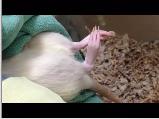Kristine Cowley, Ph.D.
Associate Professor, Physiology & Pathophysiology
University of Manitoba
- Laboratory
- 405 BMSB
- 204-789-3305
- Research
-
Improving Functional Capacity after Spinal Cord Injury: Spinal cord injury is a life-altering event for over 80 000 persons living in Canada today. Severe spinal cord damage impairs many functions, including the ability to stand, walk, and maintain balance. Other systems are affected as well, and persons living with spinal cord injury have a reduced ability to exercise, maintain a healthy body composition, and suffer from many disuse-related health problems, such as osteoporosis and increased risk of bone fracture, cardiovascular disease and type II diabetes. Our research interests focus on increasing functional capacity after SCI. We are interested in the spinal neural mechanisms underlying balance and gait, both to restore lost function and to reduce the secondary health complications related to spinal cord injury (e.g. osteoporosis).
Standing and postural control has long been described as a distinct yet essential component of locomotion, although the underlying neurochemical mechanisms contributing to standing are not clearly understood. We are interested in using an in vitro animal research model to identify the neuronal mechanisms underlying the initiation and maintenance of stance. An adult in vivo model of spinal cord injury will be used to investigate recovery of function and the therapeutic potential of motor training as well as pharmaco- and electro-therapy. This work complements other research investigating spinal cord function at the SCRC in the Department of Physiology. Findings from our research program will enhance our understanding of locomotor systems in general, and have translational implications for those living with spinal cord injury.
Pre-clinical laboratory techniques include in vivo and in vitro spinal cord injury and micro-surgical techniques, extracellular stimulation and recording in acute and chronic preparations, systems neuropharmacology, intracellular recording, retrograde neuronal cell labeling, histochemical cell labeling, behavioural and videographic kinematic motor performance assessment. Human neuromotor and exercise physiology techniques include electromyography and video-based kinematic assessment (VICON motion analysis), and metabolic spirometry.
Current Research: Current animal-based research interests include investigating whether step and stand-training provide therapeutic benefit in the early stages following spinal cord injury, investigating the neuronal mechanisms underlying extension for stance, in vitro and collaborative work with Dr Brian Schmidt (Physiology; U of M) and Dr Brian MacNeil (College of Rehabilitation Sciences; U of M) investigating whether intrathecal drug delivery can facilitate motor performance in chronic spinal cord injury.
Clinical research interests include developing therapeutic interventions that can increase functional capacity and decrease the risk of developing sedentary-related secondary consequences of spinal cord injury. Recent projects include:
Determining if optimizing the interface geometry during arm crank ergometry can enhance the ability of those with tetraplegia to engage in upper arm ergometry. Using electromyography and portable metabolic spirometry equipment we measured mechanical efficiency and muscle activity patterns in order to identify arm crank ergometer height settings that would allow those with tetraplegia to exercise for longer durations, thereby increasing their likelihood of generating a health benefit from this form of voluntary exercise. This work was carried out in collaboration with Dr Barbara Shay in the College of Rehabilitation Sciences (U of M) and Dr Jeff Leiter at the Pan Am Research Clinic. We are no longer recruiting participants for this study but thank all those who expressed an interest and participated.
Determining energy expenditure while performing different modes and intensities of voluntary exercise in persons living with tetraplegia. Participants with tetraplegia were recruited to have their energy use measured at rest and during a variety of voluntary exercises (e.g. manual wheelchair propulsion, arm crank ergometry and hand-cycling). This information will form the basis of future studies aimed at determining effective exercise volumes to confer a health benefit for those living with tetraplegia. This work was carried out in collaboration with Dr Barbara Shay in the College of Rehabilitation Sciences and Dr Jeff Leiter at the Pan Am Research Clinic. We are no longer recruiting participants for this study but thank all those who expressed an interest and participated.
Determining if passive stance, initiated in the early stage of spinal cord injury can reduce the loss of bone mineral density ubiquitous in those with motor complete paralysis. This work will be carried out in collaboration with Drs Ethans and Casey and Physiotherapist Rudy Neibuhr at the Health Sciences Centre Spinal Cord Injury Rehabilitation Hospital.
- Areas of Expertise
- In vitro electrophysiology and neuropharmacology, studies of spinal cord motor pattern generation and coordination, and adult rat spinal cord injury and motor training and recovery. Human neuromechanics, exercise physiology, and prevention and treatment of secondary complications of spinal cord injury.
- Publications
- Search PubMed for more publications by Cowley KC
- Staff
- Shannon Deschamps, Lab Technician
- Trainees
- Sarah Flett, MSc Student
- Victoria Nwachukwu, MSc Student (Co-Advisor)
- Attiyeh Vasaghi, MSc Student (Co-Advisor)

